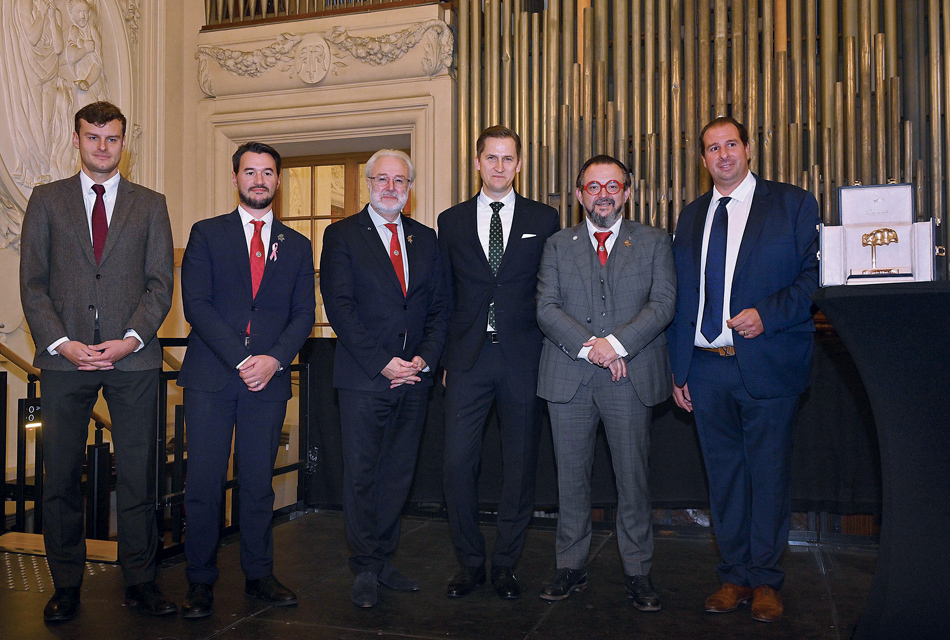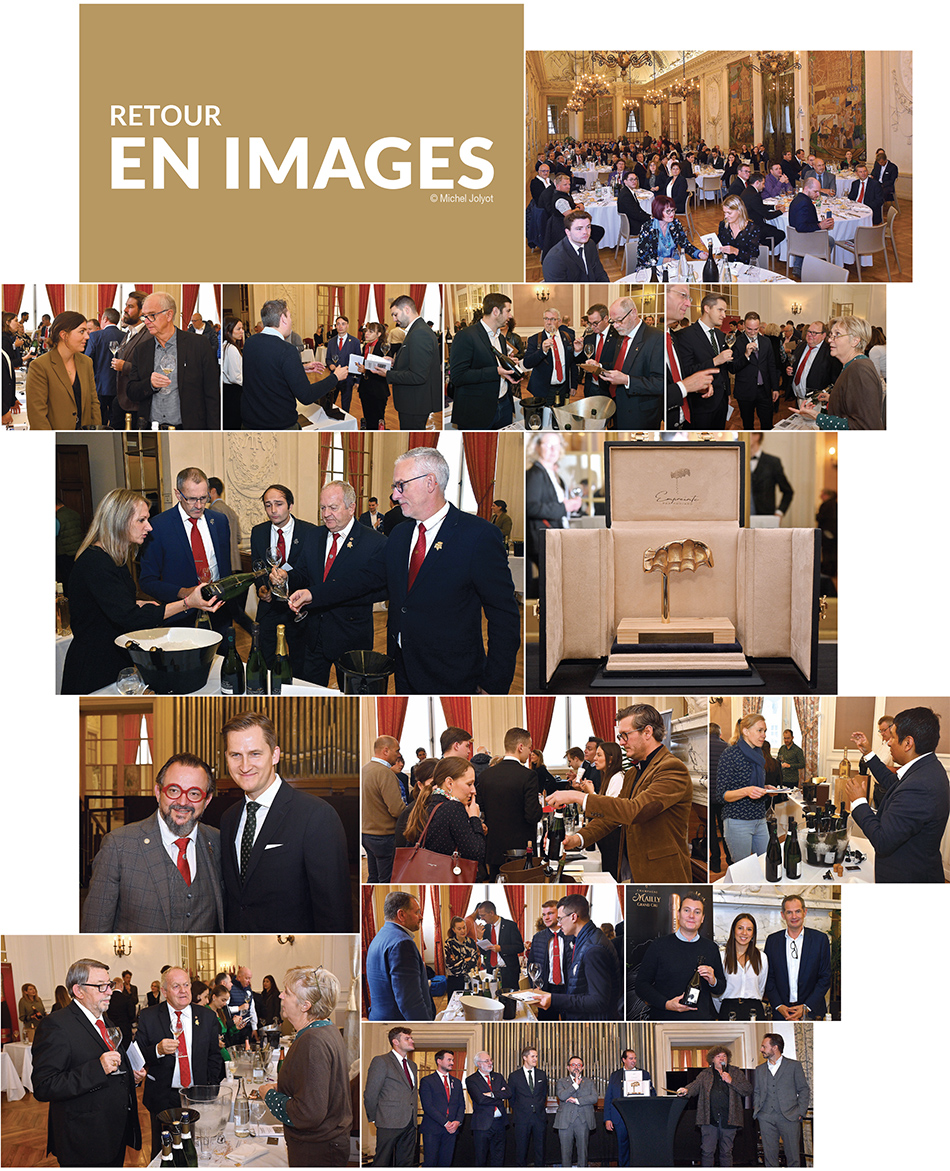
The prestigious Champagne tasting by SommelierS International has become an autumnal gathering for sommeliers and wine professionals. Approaching Champagne Day, like a herald of the celebration, this event is a grand festivity within the prestigious setting of Reims City Hall, amidst marble columns, a grand staircase, bas-reliefs, and caryatids. Stands align amidst fireplaces and oak paneling under breathtaking high ceilings. The local nature, suggested through vine and grape motifs, warmly welcomes houses, winemakers, cooperatives, ready to receive professionals from France and internationally.
For this event, prominent figures in the sommelier world were present. Notable names include Raimonds Tomsons, Best Sommelier of the World ASI, Mattia Antonio Cianca, Best Sommelier ASI of Italy and Australia, Julia Scavo, Best Sommelier of Romania ASI, as well as Philippe Faure-Brac, Best Sommelier of the World ASI, and Fabrice Sommier, Meilleur Ouvrirer de France and president of UDSF, both present to award Raimonds Tomsons the UDSF trophy honoring his title. Also in attendance were wine merchants, restaurateurs, and bloggers.

The event reflects the reality of Champagne viticulture, serving as a focal point for houses, winemakers, and cooperatives. This year, 35 industry players presented a selection of their range. With a mix of regulars and newcomers, along with tastings offered at lunch, it was possible to cover a significant portion of the selection, leaving a desire to return next year.
Most houses showcased their prestigious cuvées, often from the 2013 vintage, with some 2014 and 2015 present. Others still offered the legendary 2008 and chose to present vintage cuvées. In this regard, a few 2016s began to emerge, cooperatives revolved around 2015 with some variations, and winemakers provided the opportunity to taste more recent vintages like 2017, 2018, or 2019.
The 2013 vintage has surprises in all aspects. It transported the new generation of Champagne back two to three decades when October harvests were the norm, but it awaited a erratic cycle to reveal a style of precision, complexity, and concentration. The wines are incredibly youthful; some great cuvées are still restrained and will naturally unfold with extended ageing. 2014, heavily underestimated upon release, was a year without particular stories or extremes, except for the random appearance of the Suzukii fly in some areas, notably on the Meunier grape. Ultimately, this vintage revealed itself as mature, direct, open, charming, and capable of improving with time. As for 2015, the great cuvées appear shyly, but vintage cuvées have already made an impression; it will be remembered for its distinctive character. A warm, solar vintage, it offers a paradox similar to 2011 with its vegetal tones. This varies greatly from one style to another and depending on the taster’s sensitivity. It is interesting to note that, of all the 2015s tasted at the event in special or vintage cuvées, the herbal note evoking ferns appeared rarely.

Today, Champagne cooperative wineries are far from the image of yesteryear, that of large production units. They offer vintners an alternative path compared to Houses, creating their own brands, some already recognized nationally and internationally. The pooling of energies gives meaning to the combined efforts of cooperative winemakers, allowing them to choose to market Champagne under their own brand, as cooperative growers, or under the cooperative’s brand, under the acronym «CM» Cooperative de Manipulation. In both cases, the collective adventure multiplies qualitative effects; the final product benefits from shared expertise, investments, tools, and facilities. The six cooperatives present at the event proudly showcase the Champagne emblem, reinventing themselves year after year.
Winemakers added spice to the event, some being indispensable regulars, others representing the novelty of each year and revealing the diversity of the more or less official sub-divisions of Champagne. Indeed, neither the CIVC nor the UMC have yet defined the exact demarcation of the numerous sub-regions; the 319 crus are still broadly distributed across the Montagne and Val de Reims, the Vallée de la Marne, the Côte des Blancs and its surroundings, and the Côte des Bar. However, the division is even more fragmented. This year, the event highlighted this diversity by featuring winemakers whose signature is based on iconic Grand Crus of the Montagne de Reims such as Bouzy, Verzy, and Verzenay. These wines are structured around Pinot Noir and its various styles, depending on a more or less northern positioning and their diverse exposures. Villers-Marmery was not missing in the sector, with its expressions of Chardonnay from the Montagne, more reminiscent of Chablis. Others came from the Val de Reims, in the area between the Ardre and the Vesle, mostly on Meunier on marl, clay, and sand. The south of Epernay was also represented between the Vallée de la Marne and Côte des Blancs, where Meunier and Chardonnay share the lands. The Grande Vallée de la Marne, the small appendage of Boursault, offered other expressions of Meunier. The Côte des Bar, the realm of Pinot Noir, known also for forgotten grape varieties, was represented by two producers in addition to the two houses.
Julia Scavo / Photos : Michel Jolyot
SommelierS International would like to thank its partners:
- Lehmann Glass
- Coravin
- Caviar Maison Noble
- Empreinte par Audiard
- Les étudiants du lycée de Bazeilles